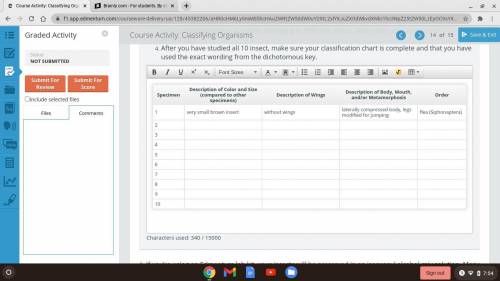
Biology, 13.01.2021 23:10 Idontreallycare16
Question 2
Now follow these directions to classify the insect specimens. Start by putting on your gloves and goggles. Then, using the forceps, remove all 15 insect specimens from the jar and put them in the petri dishes.
Be very careful when removing the insects. Wings and body structures can be easily damaged. Choose 10 insects that you want to classify using the dichotomous key, and put the remaining insects back into the solution.
The dichotomous key that came with the Edmentum lab kit has descriptions and “refer to” numbers. Start at Space 1, and determine whether your specimen has wings. Jump to the “refer to” space to further classify the organism. Continue until you reach the insect’s order. If you’re not using an Edmentum lab kit, follow the instructions for your specific dichotomous key.
Now follow these steps to further classify each specimen. Write your notes in the chart using the exact wording from the dichotomous key. An example is given in the chart.
Use the magnifying glass to identify the body parts of each insect, such as the mouth or wing structure. Use the microscope on the lowest or second-lowest setting to observe the body parts of small insects.
Place the insect in the petri dish lid, and then place it on the microscope. (The bottom part of the petri dish is too tall to fit under the microscope. Adjust the upper microscope light instead of the base light. Then move the dish around until you can see the specimen.)
In some cases, an insect’s metamorphosis will determine its final order. Use credible websites to look up the metamorphosis of insects belonging to different orders, and match your specimens accordingly.
After you have studied all 10 insect, make sure your classification chart is complete and that you have used the exact wording from the dichotomous key.


Answers: 1


Another question on Biology

Biology, 21.06.2019 23:40
When coal has reached it hardest, darkest form, it is called select one: 0 a. sub-bituminous b. lignite c. bituminous d. antrhacite next page
Answers: 3

Biology, 22.06.2019 04:30
What is used to keep track of the gamates and possible offsprings combination
Answers: 2

Biology, 22.06.2019 04:30
Which would be the most useful source of evidence to support mcneill's contention?
Answers: 3

You know the right answer?
Question 2
Now follow these directions to classify the insect specimens. Start by putting on your g...
Questions


Computers and Technology, 09.11.2019 01:31




















